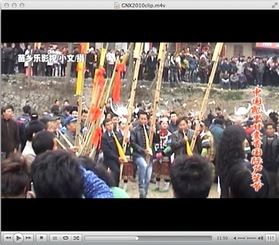 The American Anthropological Association Annual Meeting is about to begin in Denver, and I'm really looking forward to my panel this year which looks at the relations of power evoked and enabled by images of crowds. Our papers, on crowds in Turkey, China, Bangladesh, and Indonesia, will think through the politics of authority, authenticity, and sincerity embedded in photographs of crowds. My talk juxtaposes news photographs of ethnic minority delegates attending national political meetings in Beijing against amateur, locally-made videos of rural Miao festivals in which crowds of ethnic Miao people feature prominently to explore how visual imagery informs ethnic politics and subjectivities in contemporary China. We hope that these panel will prompt conversations on the significance of crowds and the workings of photographic representation in understanding the social and political power of mass gatherings. Details on the panel are below: THE CROWDED FIELD: PHOTOGRAPHING MASSES, VISUALIZING POWER Organized by Jenny Chio and Zeynep Gürsel Saturday, November 21, 8-9:45 a.m. Colorado Convention Center Room 111 Denver, CO Panel Abstract:If, as Benedict Anderson has convinced us, the rise of nationalism and the modern nation-state was spurred by the circulation of printed mass media that allowed individuals to imagine themselves as part of a greater community of like-minded citizens, what happens when communities are literally imaged, and symbolically imagined, through pictures and photographs? Crowds alternatively signal both experiences of authentic communitas and unruly disorder. Moreover, images of crowds, from rallies to protests to political assemblies, are unsettling, ambivalent indexes of political will, grassroots participation, authoritarian state power, and collective belonging. In this way, photographs of crowds simultaneously articulate and affirm the recognition of social collectivities, moving quickly from the particularity of the crowd itself, as a temporary, specific gathering of individuals, towards generalities of groups, types, and mass publics. Such photographs, and the imaginations that enliven their salience, thus encompass a multivalent site for assertions of political authority, social belonging, and newly potentiated collectivities. To examine what photographs of crowds actually do – politically, socially, culturally – this panel explores the functions of power and imagination of crowds when they are visualized. Drawing on diverse political contexts, we explore how the making of a particular image of a crowd into an icon-index of an imagined community or public is achieved through photography and visual technologies. Across our papers, we ask: How is the crowd imaged, in what forms, and for what purposes? In what spaces and forms do such images appear and circulate? Furthermore, how is a particular reading of an image of a crowd secured or unmoored as it circulates? Can a state ever create an authentic image of the nation, and what happens when an affective term such as sincerity is attributed to the collective, rather than located at the scale of the individual? What might be the politics of visibility when we consider the dialectical movements between anonymity and authority in photographs of crowds? We address these questions through ethnographic analyses of the visual representation of crowds in Turkey, China, Bangladesh and Indonesia. To begin, Gürsel explores how a state might claim and contextualize the sincerity and authenticity of the crowd, analyzing Turkey’s 2013 “National Will Rally” organized by then President Erdogan and state claims for a sincere photograph of the Turkish nation. Chio’s paper considers how ethnic minority bodies, individual and collective, are imagined in the body politic of China, from individual ethnic delegates at national assemblies to the collective ethnic crowd in local, rural video recordings. The social ambivalence of crowds as an analytic is further explored in Chowdhury’s paper on political protests against the war crimes tribunal in Bangladesh. Strassler’s comparison of crowd images and crowd-sourcing in the recent Indonesian elections draws together the themes of sincerity, authenticity, and the truth-value of photographs that inform the panel as a whole. Taken together, our aim is to build a theoretically robust understanding of the relationship between the crowd, political imaginaries, and state authority. Comments are closed.
|
Archives
April 2024
|